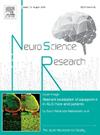内源性亨廷顿蛋白在成年小鼠脑和脊髓中的神经解剖分布及其与STB/HAP1的免疫组化关系
IF 2.4
4区 医学
Q3 NEUROSCIENCES
引用次数: 0
摘要
亨廷顿蛋白相关蛋白1 (HAP1)是耻骨样体(STB)的重要组成部分,被认为是几种神经退行性疾病(包括亨廷顿病中的亨廷顿蛋白(HTT))的神经保护性相互作用因子。先前的体外研究表明,与正常HTT相比,STB/HAP1对突变HTT具有更高的结合亲和力。然而,STB/HAP1与内源性HTT在体内的详细关系尚未明确。本研究利用光/荧光显微镜研究了内源性HTT在成年小鼠脑和脊髓中的分布及其与STB/HAP1的关系。结果表明,HTT免疫反应性高度分布于纹状体、中隔核(MS)、布氏体斜带水平肢/垂直肢核(HDB、VDB)、脑基底部(SIB)、桥脚被盖核(PPTg)、外侧背被盖核(LDTg)、自主神经节前神经元和运动神经元。超过90%的htt免疫反应(ir)神经元在MS、VBD/HDB、SIB、PPTg、LDTg和自主神经节前核中含有STB/HAP1免疫反应性。然而,纹状体和运动核中的HTT-ir神经元缺乏HAP1免疫反应性。这表明,由于缺乏STB/HAP1的保护作用,HTT-ir纹状体/运动神经元比其他表达HAP1的HTT神经元更容易发生神经变性。我们目前的研究结果可能为阐明内源性HTT和HAP1在中枢神经系统中的病理生理功能提供一个框架。本文章由计算机程序翻译,如有差异,请以英文原文为准。
Neuroanatomical distribution of endogenous huntingtin and its immunohistochemical relationships with STB/HAP1 in the adult mouse brain and spinal cord
Huntingtin-associated protein 1 (HAP1) is an essential constituent of the stigmoid body (STB) and is known as a neuroprotective interactor with causal agents for several neurodegenerative disorders, including huntingtin (HTT) in Huntington’s disease. Previous in vitro studies showed that compared to normal HTT, STB/HAP1 exhibited a higher binding affinity for mutant HTT. The detailed in vivo relationships of STB/HAP1 with endogenous HTT, however, have not been clarified yet. This study examined the distribution of endogenous HTT and its relationships with STB/HAP1 in the adult mouse brain and spinal cord using light/fluorescence microscopy. Our results show that HTT immunoreactivity is highly distributed in the striatum, medial septal nucleus (MS), nucleus of the horizontal limb/ vertical limb of the diagonal band of Broca (HDB, VDB), substantia innominata basal part (SIB), pedunculopontine tegmental nucleus (PPTg), laterodorsal tegmental nucleus (LDTg), autonomic preganglionic neurons, and brainstem/spinal motoneurons. More than 90 % of HTT-immunoreactive (ir) neurons contain STB/HAP1 immunoreactivity in MS, VBD/HDB, SIB, PPTg, LDTg, and autonomic preganglionic nuclei. HTT-ir neurons in the striatal and motor nuclei, however, do not exhibit HAP1 immunoreactivity. These suggest that due to the absence of STB/HAP1-protectivity, HTT-ir striatal/motor neurons are more vulnerable to neurodegeneration than other HAP1-expressing HTT neurons. Our current findings might provide a framework for elucidating the pathophysiological functions of endogenous HTT and HAP1 in the central nervous system.
求助全文
通过发布文献求助,成功后即可免费获取论文全文。
去求助
来源期刊

Neuroscience Research
医学-神经科学
CiteScore
5.60
自引率
3.40%
发文量
136
审稿时长
28 days
期刊介绍:
The international journal publishing original full-length research articles, short communications, technical notes, and reviews on all aspects of neuroscience
Neuroscience Research is an international journal for high quality articles in all branches of neuroscience, from the molecular to the behavioral levels. The journal is published in collaboration with the Japan Neuroscience Society and is open to all contributors in the world.
 求助内容:
求助内容: 应助结果提醒方式:
应助结果提醒方式:


